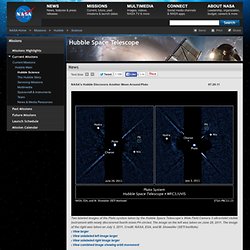

Pluto's Cousins. Pluto: A Dwarf Planet Oddity (Infographic) Pluto moon discovery hints at future surprises for NASA probe. Skip to next paragraph Subscribe Today to the Monitor Click Here for your FREE 30 DAYS ofThe Christian Science MonitorWeekly Digital Edition The tiny new moon — announced July 20 and called P4 for now — brings the number of known Pluto satellites to four.

And the find, made with the Hubble Space Telescope, suggests that NASA's New Horizons probe could make some big discoveries, too, when it makes a close flyby of Pluto in 2015, researchers said. "The discovery of P4 just reinforces what we knew before: This is going to be completely new territory," said Hal Weaver, New Horizons project scientist at the Johns Hopkins University Applied Physics Laboratory in Laurel, Md.
A long journey The New Horizons spacecraft launched in January 2006 on a mission to study the faraway Pluto system, which has never been visited by a probe. Since its launch, New Horizons has traveled more than 1.8 billion miles (2.9 billion kilometers), and it's slated to make a close pass of Pluto in July 2015. Hubble Discovers New Pluto Moon. Pluto may have been demoted to dwarf planet status, but it’s queen bee to a clutch of moons that now numbers four.

S Hubble Discovers Another Moon Around Pluto. NASA's Hubble Discovers Another Moon Around Pluto Two labeled images of the Pluto system taken by the Hubble Space Telescope's Wide Field Camera 3 ultraviolet visible instrument with newly discovered fourth moon P4 circled.

The image on the left was taken on June 28, 2011. The image of the right was taken on July 3, 2011. Credit: NASA, ESA, and M. New moon of Pluto: P4. NASA Administrator Announces Science Mission Directorate Leadeship Changes. WASHINGTON - NASA Administrator Michael D.

Griffin issued the following statement Wednesday regarding the announcement that Dr. S. Alan Stern, NASA associate administrator for the Science Mission Directorate, has decided to leave the agency. Alan Stern Resigns From NASA. Want to stay on top of all the space news?

Follow @universetoday on Twitter Alan Stern has stepped down as NASA’s associate administrator for the Science Mission Directorate. No word on Stern’s reasons for leaving, or why such an abrupt departure, but the timing suggests it could be related to the erroneous announcement that funding for the Mars Rovers would be cut. Stern was seemingly highly respected and very popular among mission scientists and designers, and Stern had pledged to toe the line about mission spending and cost overruns.
Weiler to Replace Stern as NASA Science Chief. This story was updated 11:35 a.m.

EDT. — NASA is recalling Goddard Space Flight Center Director Ed Weiler to the space agency's headquarters here to take over the Science Mission Directorate in the wake of Alan Stern's resignation. Stern, a seasoned planetary scientist who joined NASA in April 2007 to pursue a reform-minded agenda, informed colleagues in an e-mail March 26 that he would be leaving the agency in the month ahead. In his e-mail, which he sent out at 8:34 a.m., according to the time stamp, Stern said that he offered his resignation March 25 and that NASA Administrator Mike Griffin "reluctantly accepted" it. Alan Stern. S.

Alan Stern (born 22 November 1957, New Orleans, Louisiana) is an American planetary scientist. He is the principal investigator of the New Horizons mission to Pluto and the Chief Scientist at Moon Express.[1][2] Stern has been involved in 24 suborbital, orbital, and planetary space missions, including eight for which he was the mission principal investigator. One of his projects was the Southwest Ultraviolet Imaging System, an instrument which flew on two space shuttle missions, STS-85 in 1997 and STS-93 in 1999.[3][4] Stern has also developed eight scientific instruments for planetary and near-space research missions and has been a guest observer on numerous NASA satellite observatories, including the International Ultraviolet Explorer, the Hubble Space Telescope, the International Infrared Observer and the Extreme Ultraviolet Observer. Dr. Alan Stern named Chief Scientist for Moon Express. Moon Express Announces Dr. Alan Stern as Chief Scientist.
Internationally recognized planetary scientist Dr.

Alan Stern becomes Chief Science Officer of commercial lunar enterprise Moon Express Mountain View, CA (July 20, 2011) - Moon Express, a Google Lunar X PRIZE contender, revealed today that internationally recognized planetary scientist Dr. Alan Stern will be the Chief Scientist and Mission Architect for the company. The announcement was made as lunar scientists from around the world gather at the NASA Ames Research Park for their annual Lunar Science Forum, convened by the NASA Lunar Science Institute. Dr. Named by Time Magazine as one of the word's most influential people, Dr. "We are honored to have a scientist of Alan Stern's caliber working with us,i said Moon Express co-founder and CEO Dr. About Moon Express Selected by Forbes as one of the '15 Names You Should Know', Moon Express (MoonEx) is a privately funded lunar transportation and data services company based at the NASA Ames Research Park in Silicon Valley.
Pluto. Pluto, plus moons: Charon, Nix & Hydra.

A recent discovery (July 2011) shows that Pluto has four moons: Charon, Nix, P4, and Hydra. Pluto is on land side. Kuiper belt is surf. Heliopause & Oort cloud = continental shelf... Deep space is like the oceans & sea... Looking to distans shores. Pluto song. Notes From the Pluto Files. Notes From the Pluto Files Posted January 1, 2010 DAVID LEVIN: You're listening to a NOVA podcast.

I'm David Levin. In 2006 an international gathering of astrophysicists declared that Pluto would no longer be called a planet. Neil deGrasse Tyson had no problem with the choice. But why has a distant icy rock been the center of such controversy? In this podcast, Neil talks to Terri about their experience. TERRI RANDALL: We never really got a chance to talk about your reaction to the trip cross country. NEIL deGRASSE TYSON: No, we didn't. TERRI RANDALL: And I was wondering, what was it like to meet the Tombaugh family? NEIL deGRASSE TYSON: I didn't know what to expect, and I have to tell you, that has got to be the friendliest family I have ever spent time with in my life. And having a full conversation with Clyde's 97-year-old widow who spoke lucidly and articulately about their life together when Clyde was younger and their later years. Pluto Is Not a Planet - Explore the Cosmos. Clyde Tombaugh. Clyde William Tombaugh (February 4, 1906 – January 17, 1997) was an American astronomer.
Although he is best known for discovering the dwarf planet Pluto in 1930, the first object to be discovered in what would later be identified as the Kuiper belt, Tombaugh also discovered many asteroids; he also called for the serious scientific research of unidentified flying objects, or "U.F.O.s". Biography[edit] Following his discovery of Pluto, Tombaugh earned bachelor's and master's degrees in astronomy from the University of Kansas in 1936 and 1938.[2] During World War II he taught naval personnel navigation at Northern Arizona University.[2] He worked at White Sands Missile Range in the early 1950s, and taught astronomy at New Mexico State University from 1955 until his retirement in 1973.
The asteroid 1604 Tombaugh,[3] discovered in 1931, is named after him. In August 1992, JPL scientist Robert Staehle called Tombaugh, requesting permission to visit his planet. Death[edit] Family[edit] Pluto (mythology) God in Greek mythology Pluton (1884–86) by Henri Chapu, part of a pair with a standing Persephone gathering flowers Hydria (ca. 340 BC) depicting figures from the Eleusinian Mysteries Plouton with cornucopia (Attic red-figure amphora, ca. 470 BC) Laurel's Pluto Blog. Mike Brown.